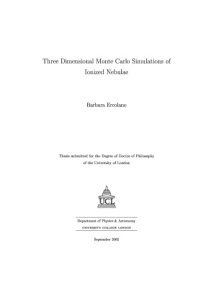
Ebook: Three dimensional Monte Carlo simulations of ionized nebulae
Author: Barbara Ercolano
- Genre: Physics // Astronomy
- Year: 2002
- Publisher: University College London (University of London)
- Language: English
- pdf
The study of photoionized environments is fundamental to many astrophysical problems. Up to the present most photoionization codes have numerically solved the equations of radiative transfer by making the extreme simplifying assumption of spherical symmetry. Unfortunately very few real astronomical nebulae satisfy this requirement. To remedy these shortcomings, a self-consistent, three-dimensional radiative transfer code has been developed using Monte Carlo techniques. The code, Mocassin, is designed to build realistic models of photoionized nebulae having arbitrary geometries and density distributions with both the stellar and diffuse radiation fields treated self-consistently. In addition, the code is capable of treating one or more exciting stars located at non-central locations. The gaseous region is approximated by a cuboidal Cartesian grid composed of numerous cells. The physical conditions within each grid cell are determined by solving the thermal equilibrium and ionization balance equations. This requires a knowledge of the local primary and secondary radiation fields, which are calculated self-consistently by locally simulating the individual processes of ionization and recombination. The main structure and computational methods used in the Mocassin code are described in this thesis. Mocassin has been benchmarked against established one-dimensional spherically symmetric codes for a number of standard cases, as defined by the Lexington/Meudon photoionization workshops (Pequignot, 1986; Ferland et al., 1995; Pequignot et al., 2001). The results obtained for the benchmark cases are satisfactory and are presented in this work. A performance analysis has also been carried out and is discussed here. The code has been applied to construct a realistic model of the planetary nebula NGC 3918. Three different geometric models were tried, the first being the biconical density distribution already used by Clegg et al. (1987). In this model the nebula is approximated by a biconical structure of enhanced density, embedded in a lower density spherical region. Spindle-like density distributions were used for the other two models (models A and B). Model A used a mass distribution slightly modified from one of Mellema's (1996) hydrodynamical models that had already been adopted by Corradi et al. (1999) for their observational analysis of NGC 3918. The spindle-like model B instead used an analytical expression to describe the shape of the inner shell of this object as consisting of an ellipsoid embedded in a sphere. The effects of the interaction of the diffuse fields coming from two adjacent regions of different densities were investigated. These are found to be non-negligible, even for the relatively uncomplicated case of a biconical geometry. It was found that the ionization structure of low ionization species near the boundaries is particularly affected. All three models provided acceptable matches to the integrated nebular optical and ultraviolet spectrum. Large discrepancies were found between all of the model predictions of infrared fine-structure line fluxes and ISO SWS measurements. This was found to be largely due to an offset of ~ 14 arcsec from the centre of the nebula that affected all of the ISO observations of NGC 3918. For each model, projected emission-line maps and position-velocity diagrams from synthetic long-slit spectra were also produced, which could be compared to recent HST images and ground-based long-slit echelle spectra. This comparison showed that spindle-like model B provided the best match to the observations. It was therefore shown that although the integrated emission line spectrum of NGC 3918 can be reproduced by all three of the three-dimensional models investigated in this work, the capability of creating projected emission-line maps and position-velocity diagrams from synthetic long-slit spectra was crucial in constraining the structure of this object. A model of one of the hydrogen deficient knots (J3) of the born-again planetary nebula Abell 30 has also been constructed. Chemical and density inhomogeneities within the knots are included in order to reproduce the observed spectrum. The final model consists of a dense core of highly C-O-enriched material, surrounded by an optically thin envelope of hydrogen-deficient material with somewhat less enhanced C and O abundances. A simplified treatment of dust photoelectric heating was implemented for this model, and it was found that dust grains played a very important role in the energy balance of the knot, providing the dominant source of heating via their photoelectron emission in the optically thin outer layer. A dust-to-gas ratio of 0.05 by mass was sufficient to obtain a temperature structure in the knot, which was suitable for the observed spectroscopic features to be produced.
Download the book Three dimensional Monte Carlo simulations of ionized nebulae for free or read online
Continue reading on any device:

Last viewed books
Related books
{related-news}
Comments (0)